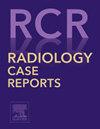血管内支架植入术治疗坏死性胰腺炎肠系膜上静脉糜烂:一种罕见并发症的救命干预
Q4 Medicine
引用次数: 0
摘要
血管并发症虽然罕见,但却显著增加了坏死性胰腺炎(NP)的发病率和死亡率。虽然动脉假性动脉瘤有充分的文献记载,但主要静脉损伤,特别是肠系膜上静脉(SMV)侵蚀,是非常罕见的,文献中只有2例报道。我们描述了一个41岁的男性重症坏死性胰腺炎合并腹部筋膜室综合征,谁发展急性,危及生命的出血由于胰腺酶侵蚀的SMV。手术试图控制出血是不成功的,出血最终通过血管内支架移植SMV处理。该病例强调了胰腺炎血管损伤的复杂性,并强调了血管内干预的潜在作用,如静脉支架移植,当传统手术技术失败时,作为挽救生命的手术。我们的病例增加了有限但越来越多的证据支持在NP中使用静脉支架治疗肠系膜静脉损伤。本文章由计算机程序翻译,如有差异,请以英文原文为准。
Endovascular stent grafting for superior mesenteric vein erosion in necrotizing pancreatitis: A lifesaving intervention in a rare complication
Vascular complications, though rare, significantly increase the morbidity and mortality associated with necrotizing pancreatitis (NP). While arterial pseudoaneurysms are well-documented, major venous injuries, particularly superior mesenteric vein (SMV) erosion, are exceedingly uncommon, with only 2 cases previously reported in the literature. We describe a 41-year-old male with severe necrotizing pancreatitis complicated by abdominal compartment syndrome, who developed acute, life-threatening hemorrhage due to pancreatic enzyme erosion of the SMV. Surgical attempts to control the bleeding were unsuccessful, and the hemorrhage was ultimately managed with endovascular stent grafting of the SMV. This case underscores the complexity of vascular injuries in pancreatitis and highlights the potential role of endovascular interventions, such as venous stent grafting, as life-saving procedures when conventional surgical techniques fail. Our case adds to the limited but growing body of evidence supporting the use of venous stenting for mesenteric venous injuries in NP.
求助全文
通过发布文献求助,成功后即可免费获取论文全文。
去求助
来源期刊

Radiology Case Reports
Medicine-Radiology, Nuclear Medicine and Imaging
CiteScore
1.10
自引率
0.00%
发文量
1074
审稿时长
30 days
期刊介绍:
The content of this journal is exclusively case reports that feature diagnostic imaging. Categories in which case reports can be placed include the musculoskeletal system, spine, central nervous system, head and neck, cardiovascular, chest, gastrointestinal, genitourinary, multisystem, pediatric, emergency, women''s imaging, oncologic, normal variants, medical devices, foreign bodies, interventional radiology, nuclear medicine, molecular imaging, ultrasonography, imaging artifacts, forensic, anthropological, and medical-legal. Articles must be well-documented and include a review of the appropriate literature.
 求助内容:
求助内容: 应助结果提醒方式:
应助结果提醒方式:


